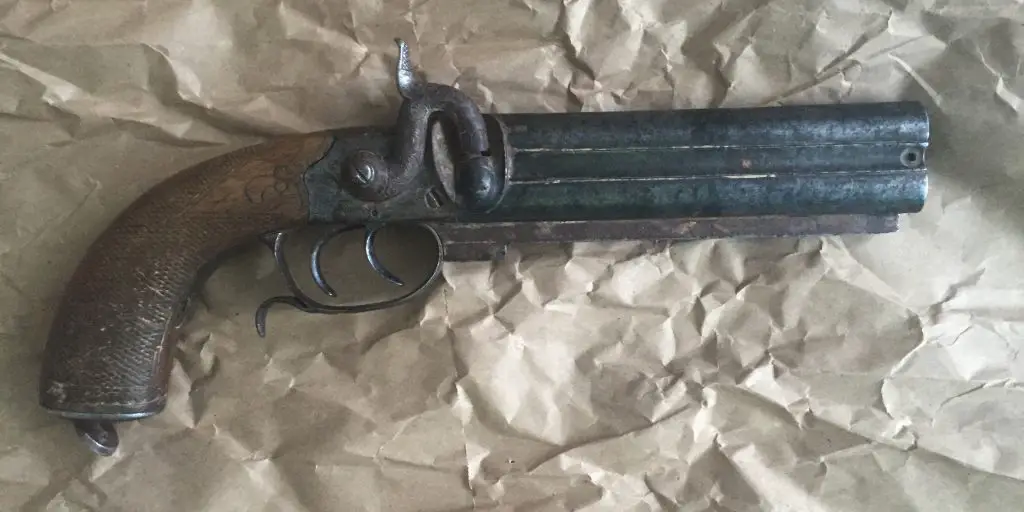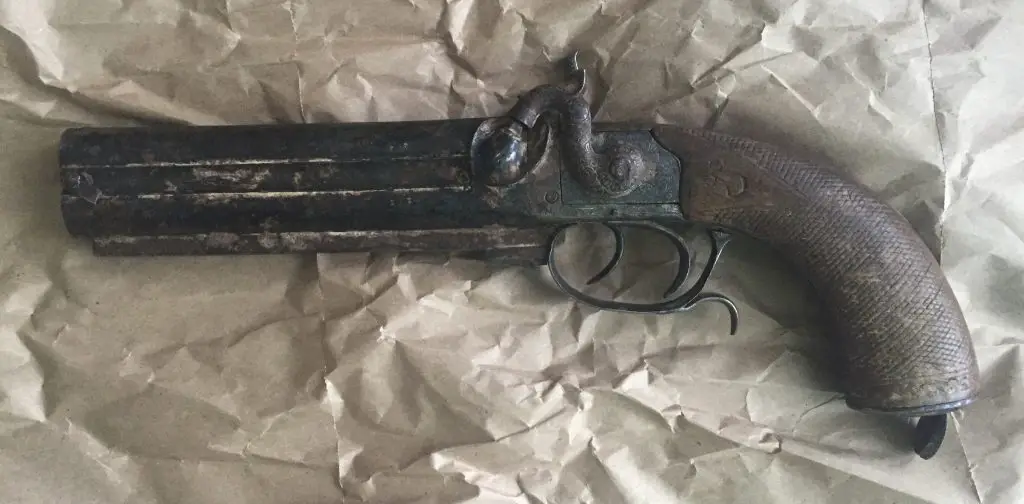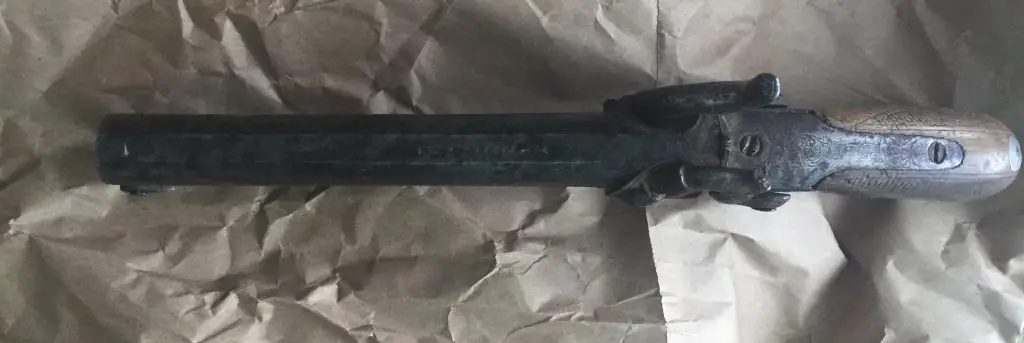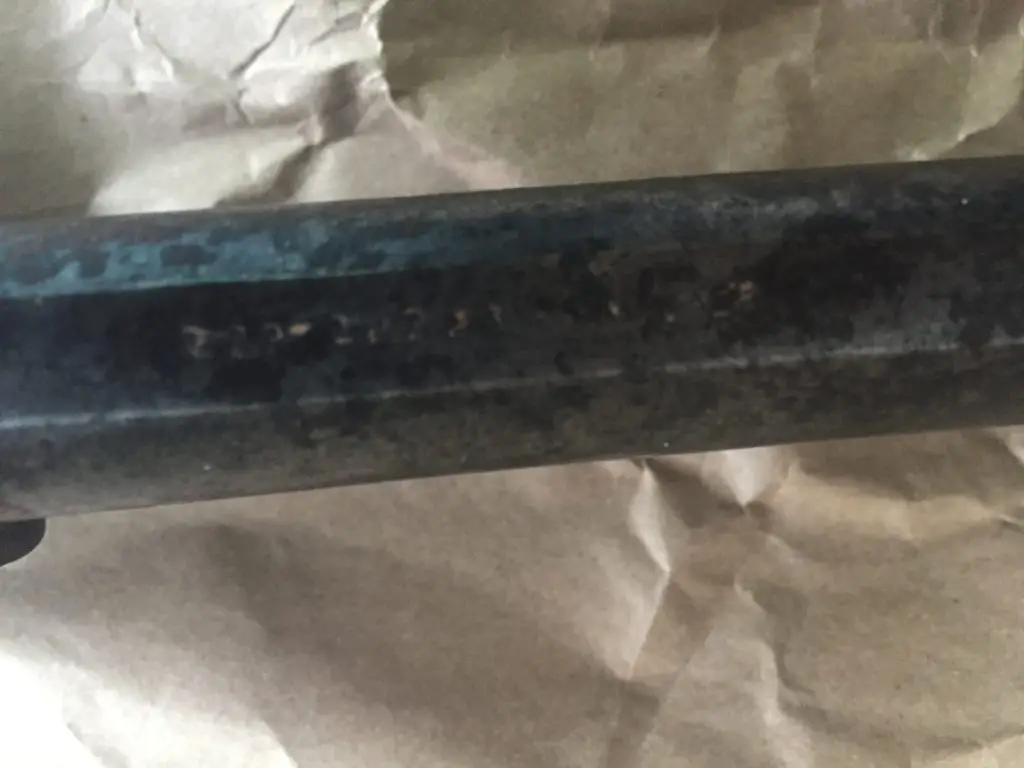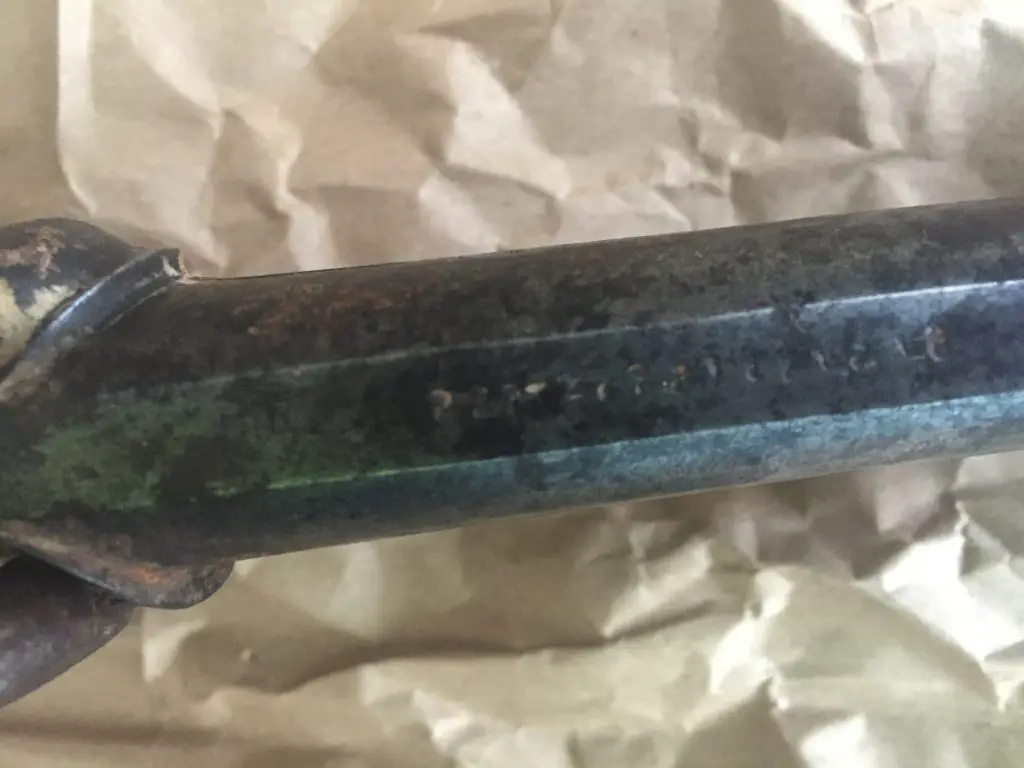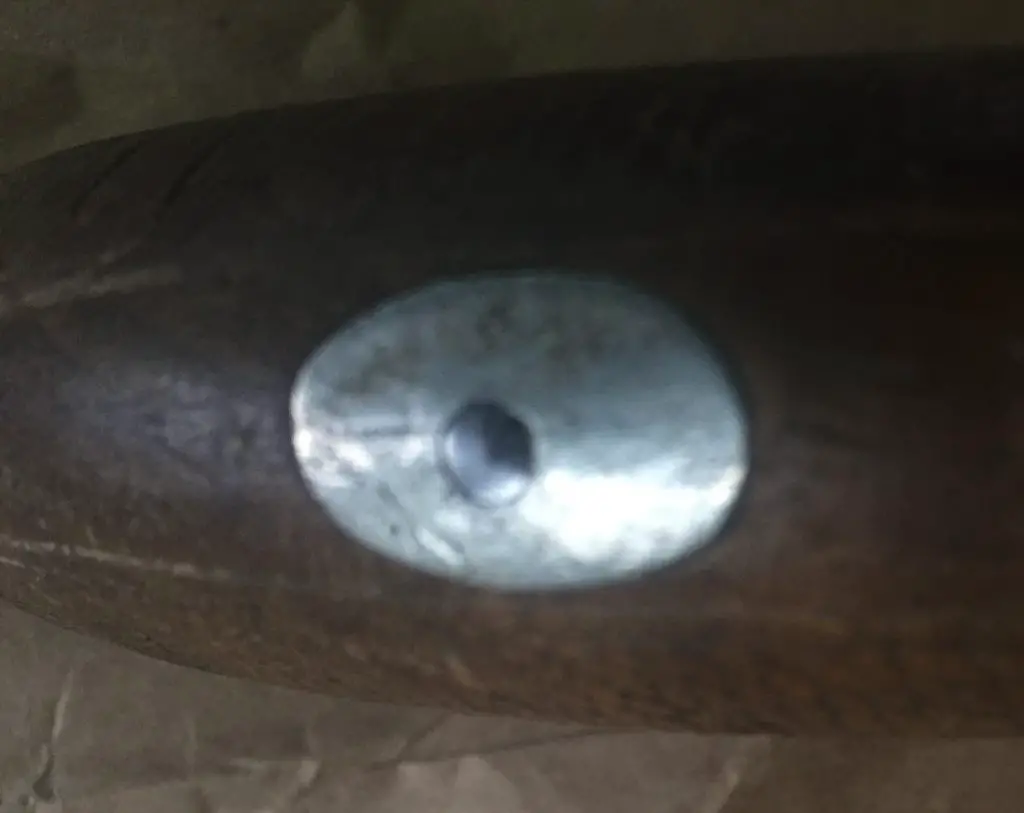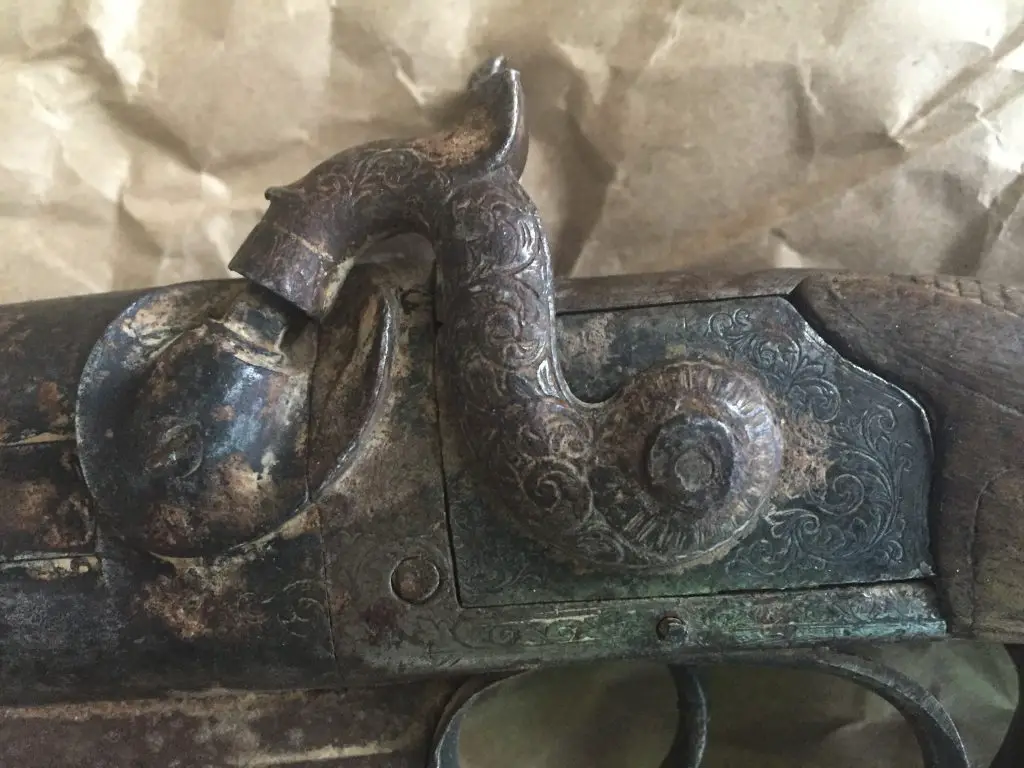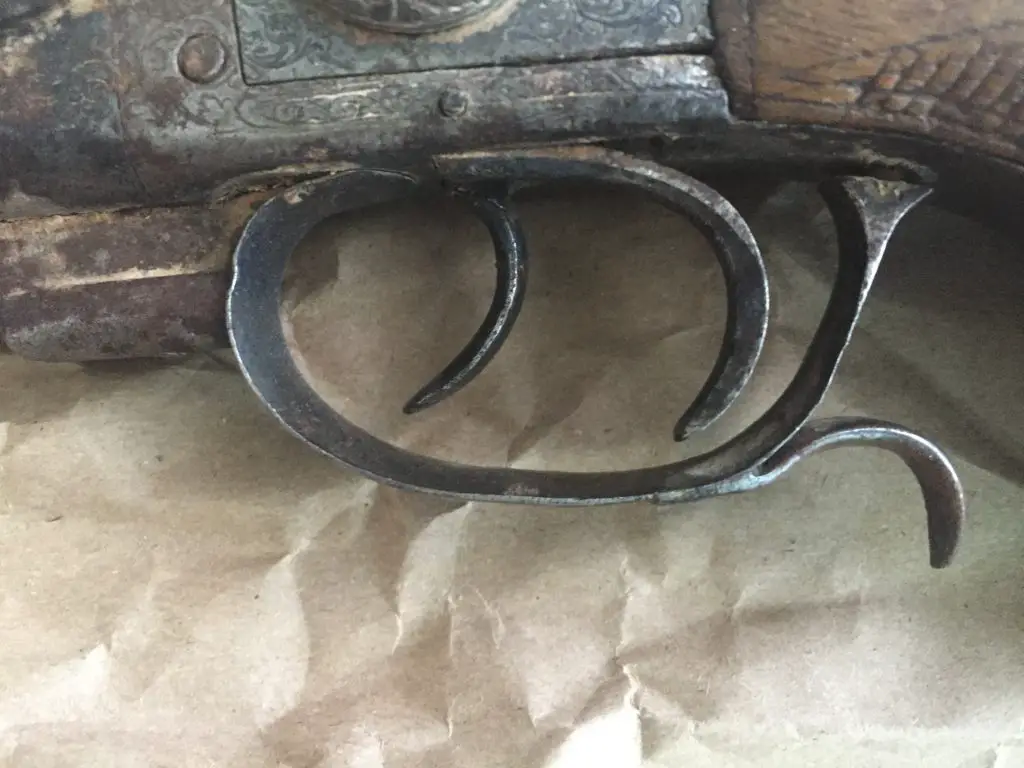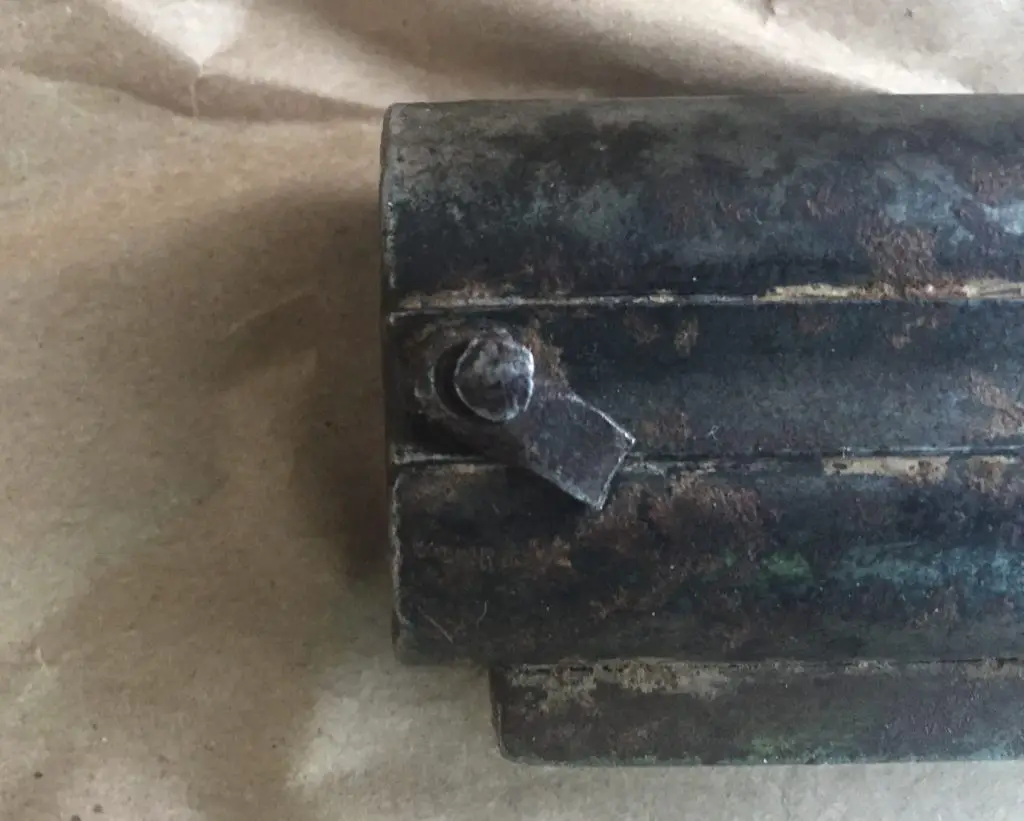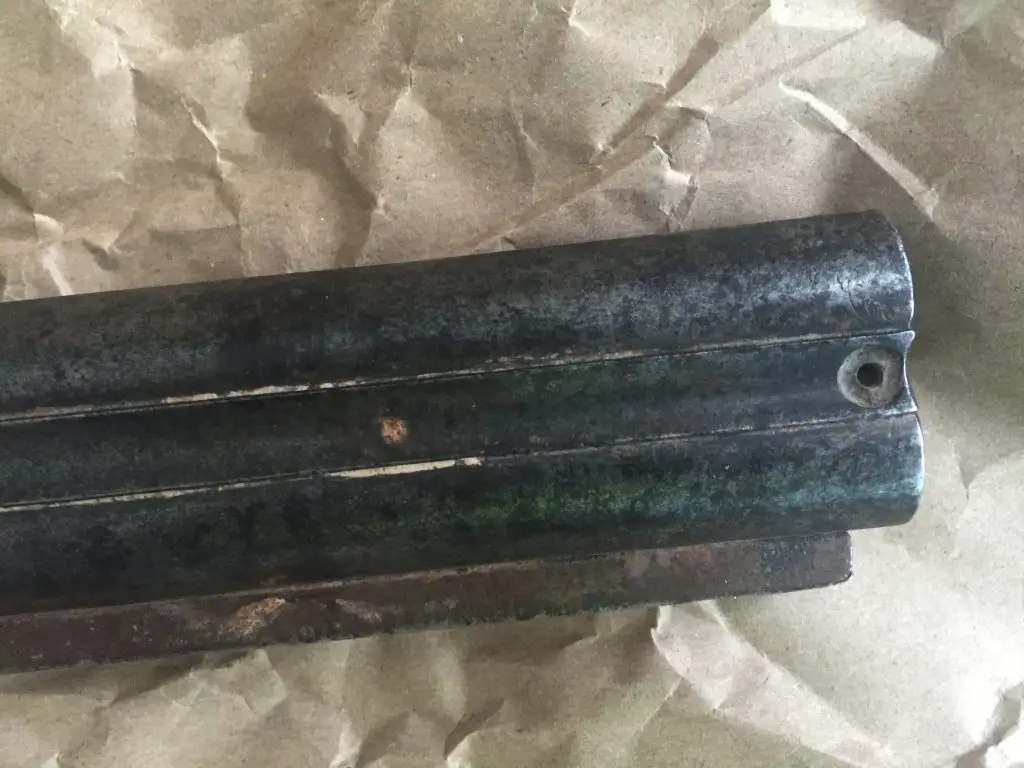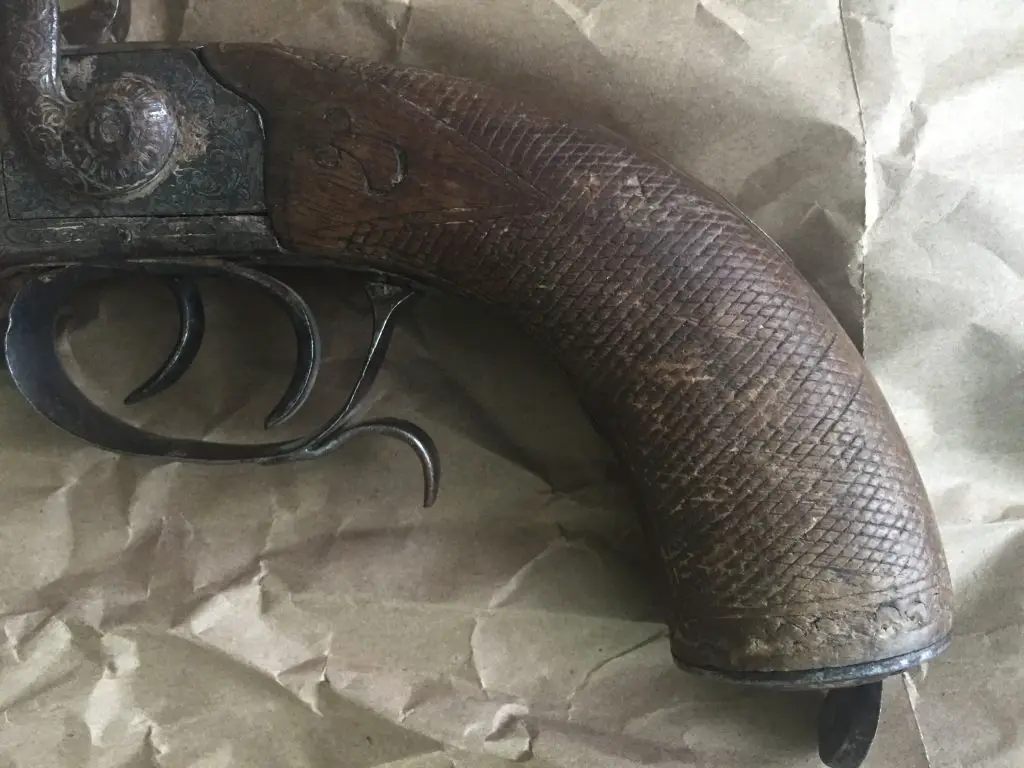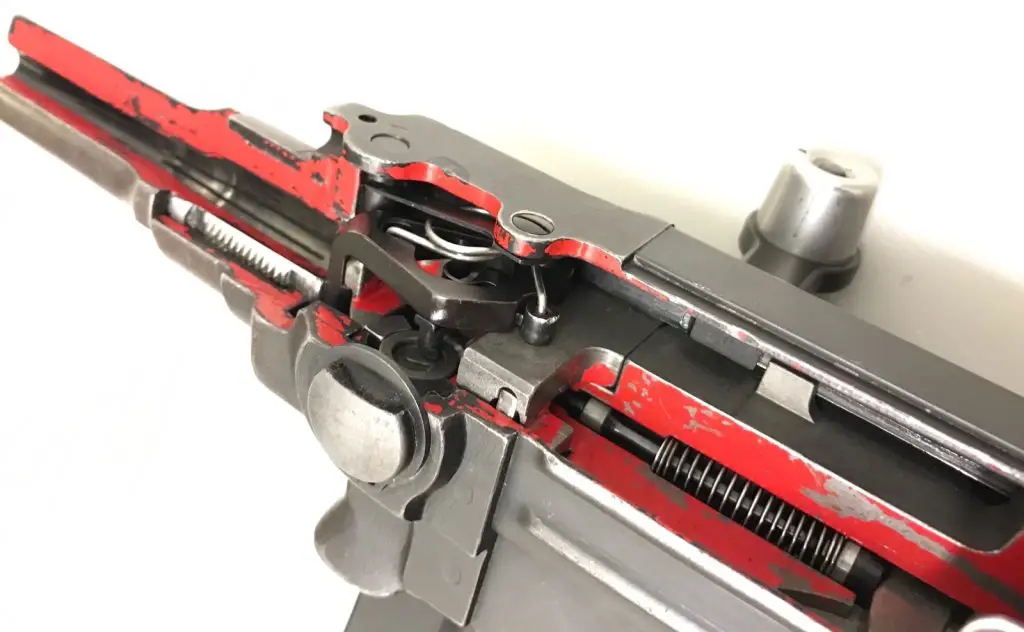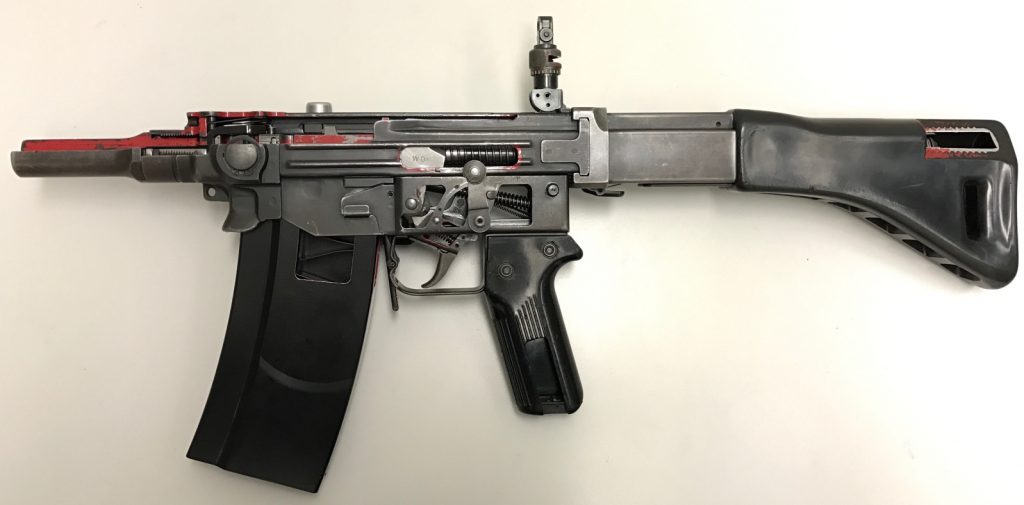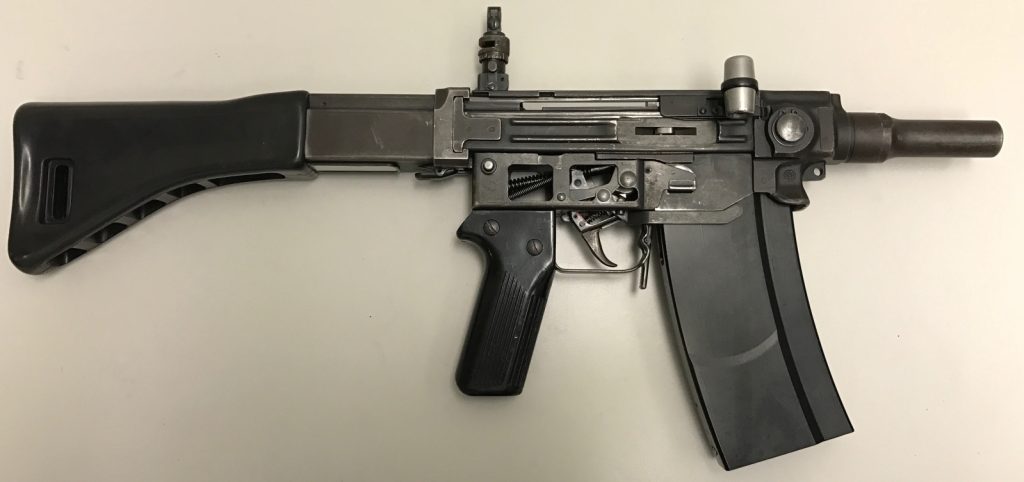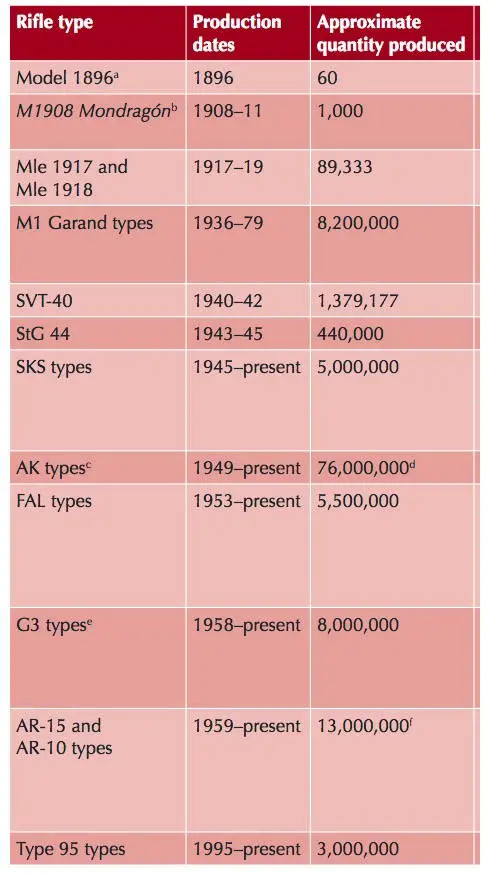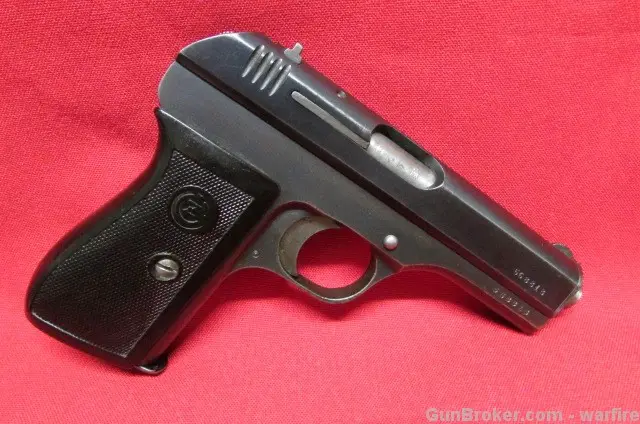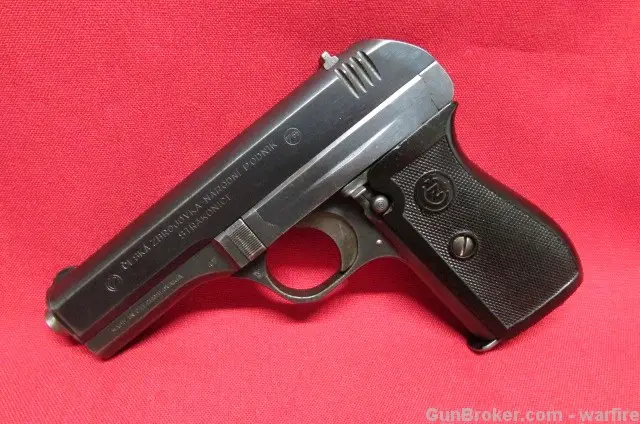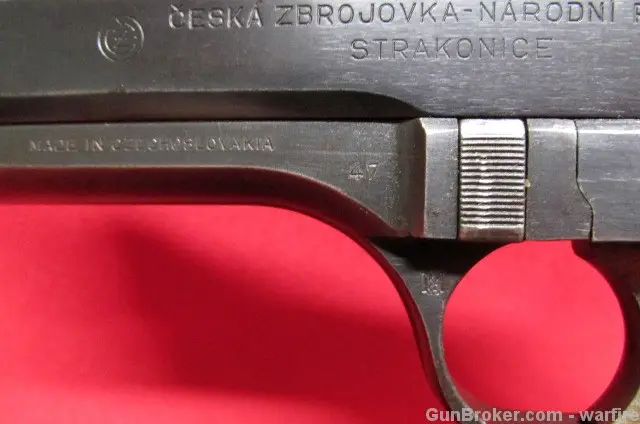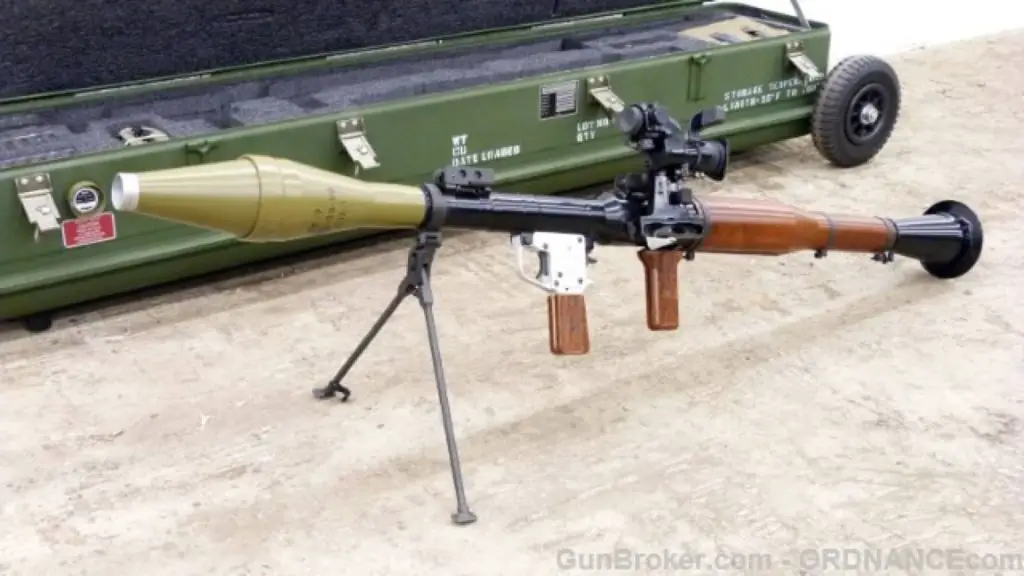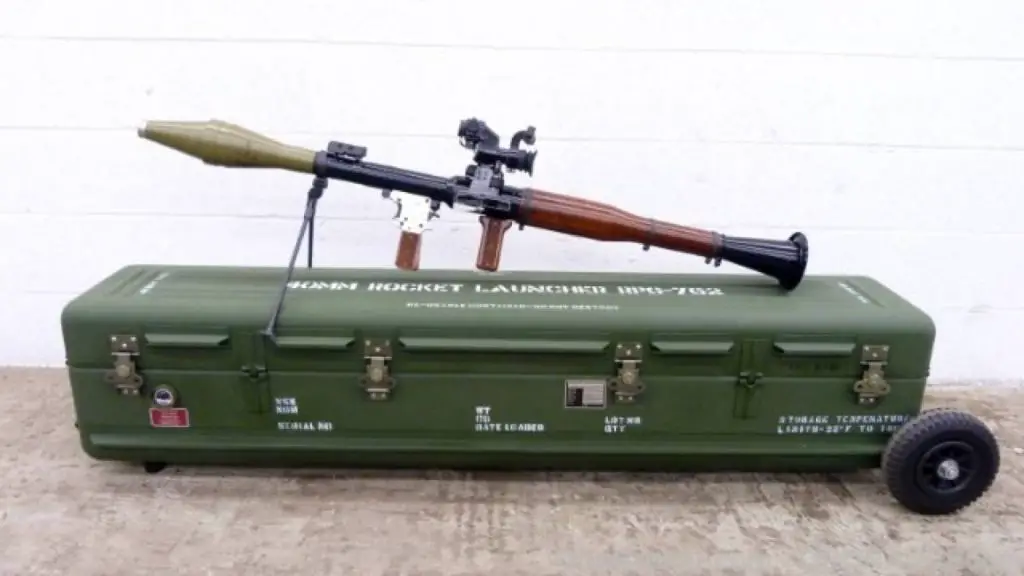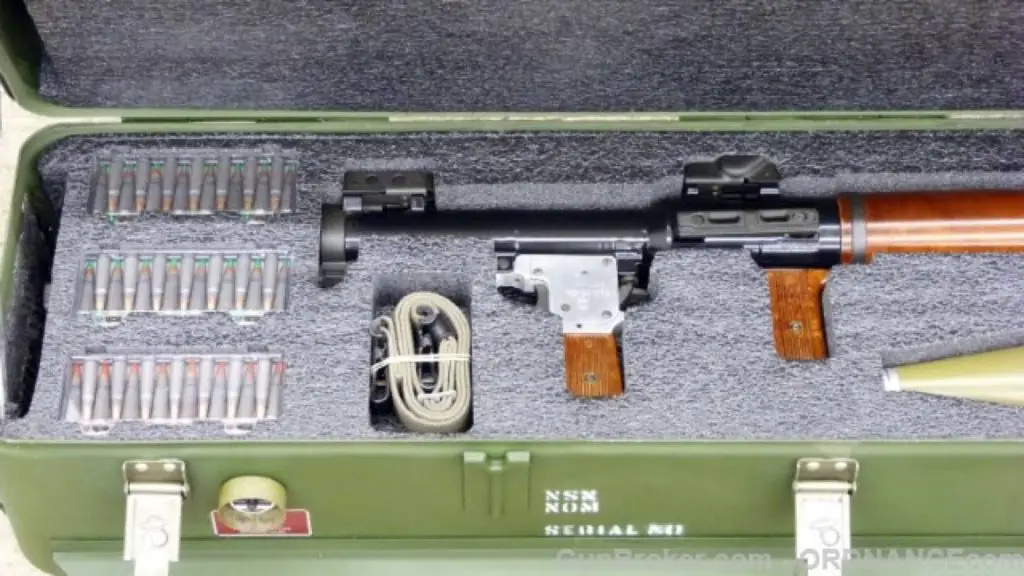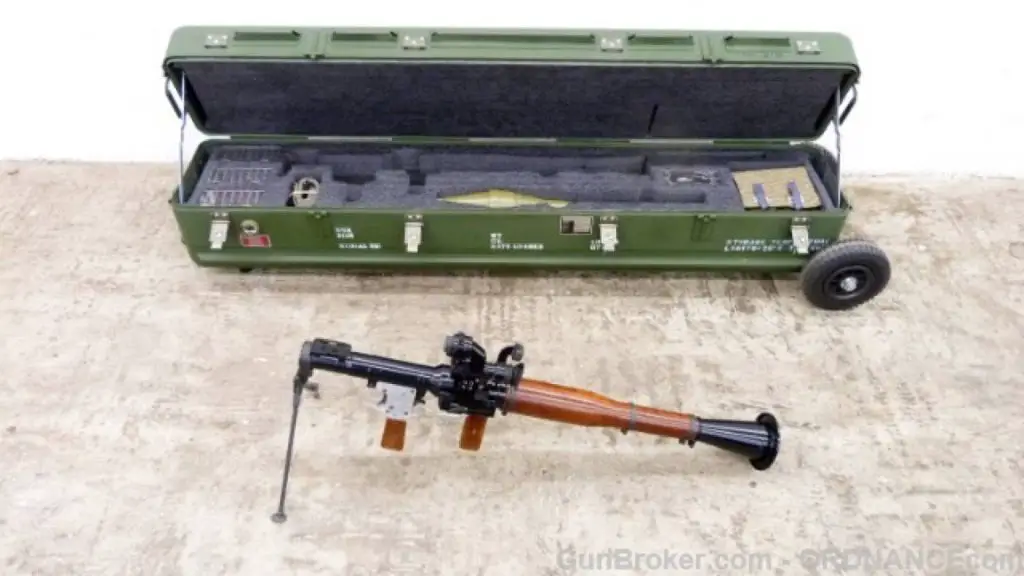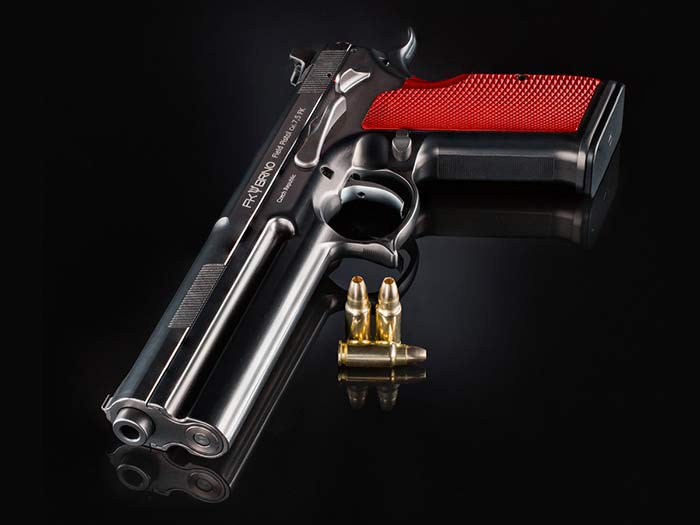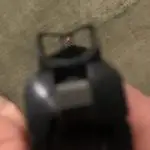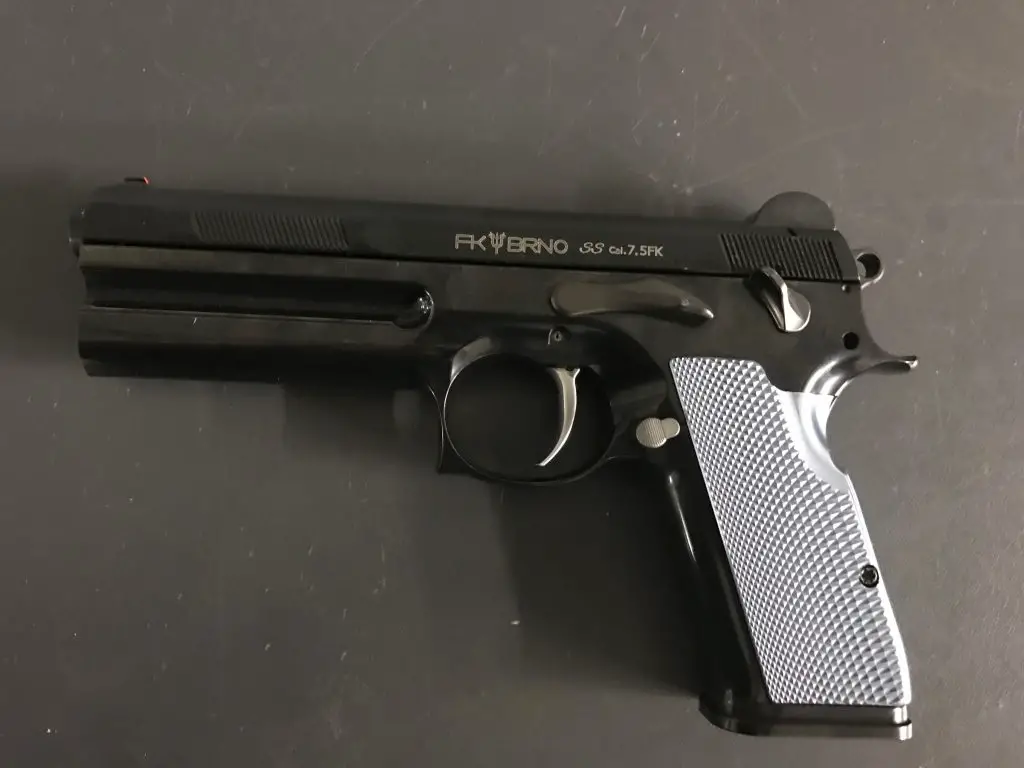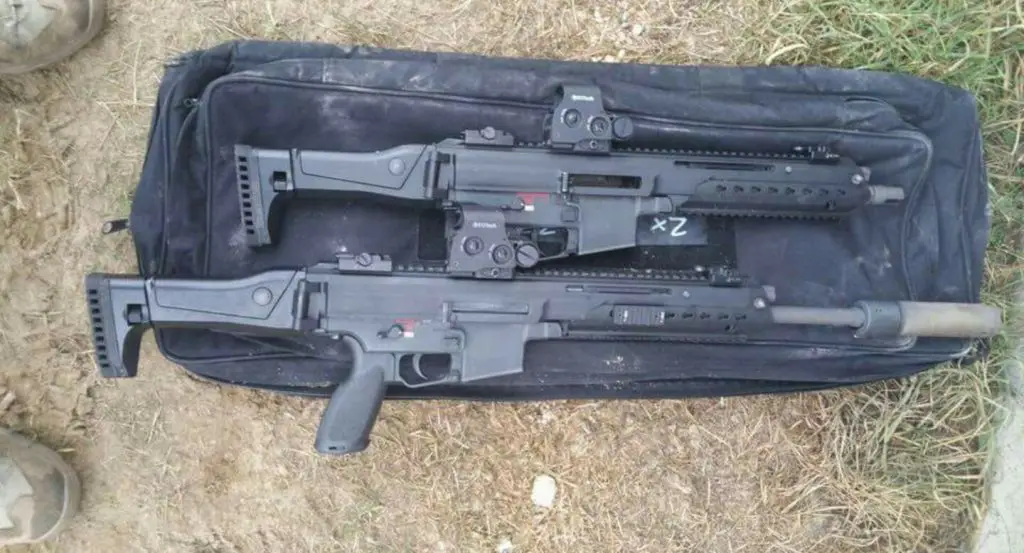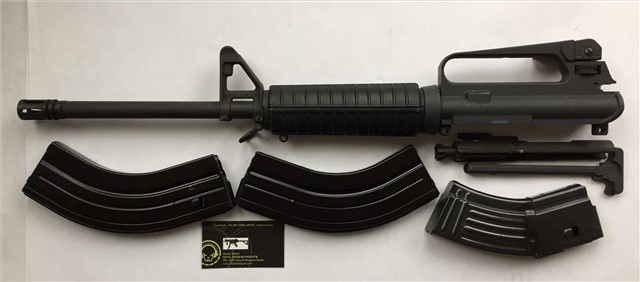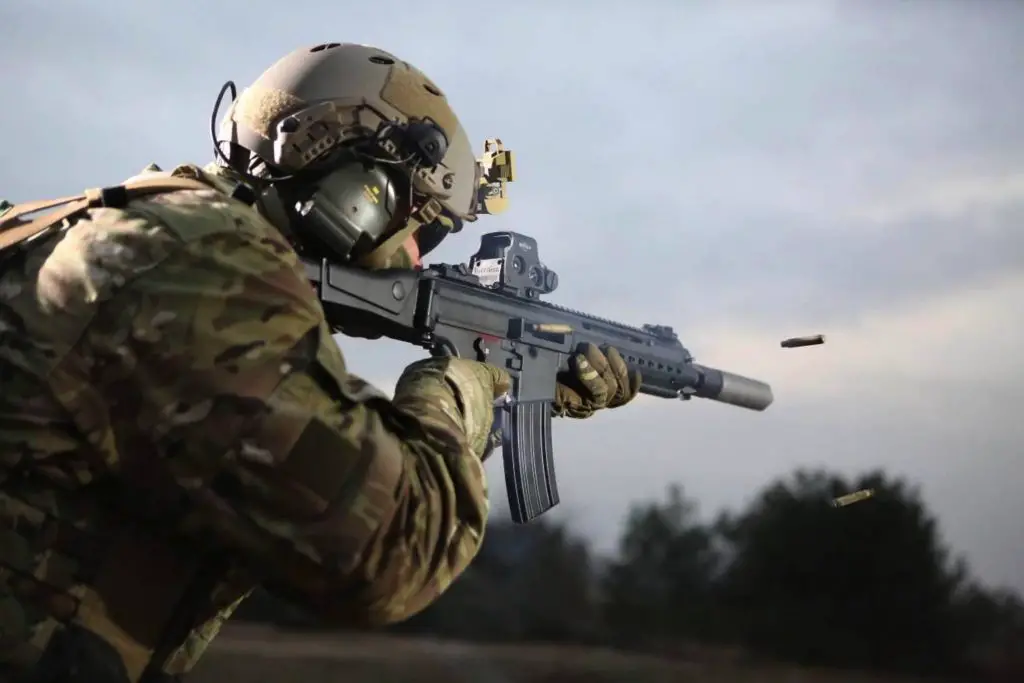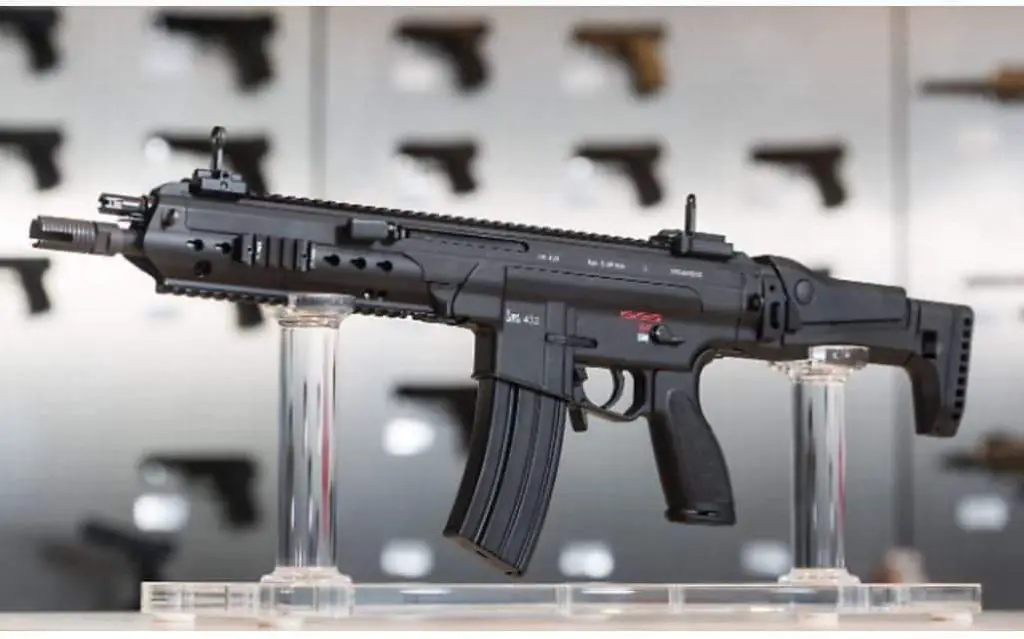Category Archives: Foreign and Enemy Weapons
Today, we have another mystery pistol, this one from the collection of Your Humble Blogger. Like all guns it comes with a story: it was a “broken gun” that was offered for sale by an Afghan villager, and it then inspired an intelligence operation that ran for some months.
It is of perceptibly higher quality than most of its contemporaries from Darra Adam Khel and other local forges, but neither the fit, the engraving nor, especially, the checkering, resemble the 19th Century British over/under pistols on which it is modeled.
Double barrel firearms offered the 19th Century combatant, or sportsman, the prospect of a second shot without having to depend on what was not yet called the New York Reload. As a result, double-barreled percussion and pinfire pistols are common, until they are eclipsed by all sizes of revolvers.
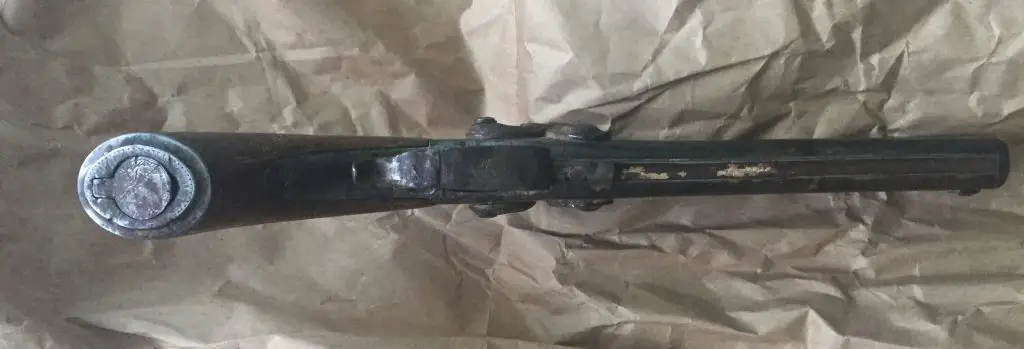 There is a trap in the grip, presumably for holding percussion caps. Its spring is broken or absent.
There is a trap in the grip, presumably for holding percussion caps. Its spring is broken or absent.
It is engraved with some gibberish along the top rib, possibly in an alphabet of some kind completely unknown to us. Or perhaps they are numbers, (apologies for photo quality, and for the fact we can’t tell which side is up).
There is worn-off inscription on a silver disc on the grip. (Apologies again for poor focus).
As mentioned, it is broken and in poor condition. Some rich bluing remains. The springs are still strong and the hammers still move, but one has lost its spur, and neither sets the trigger.
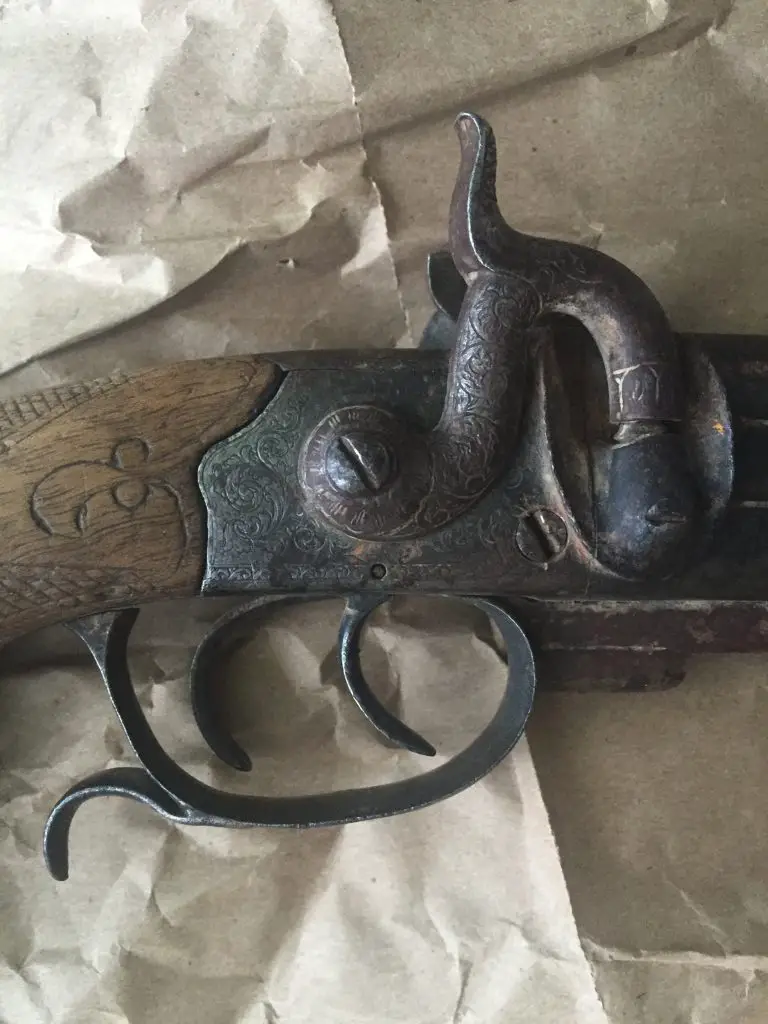
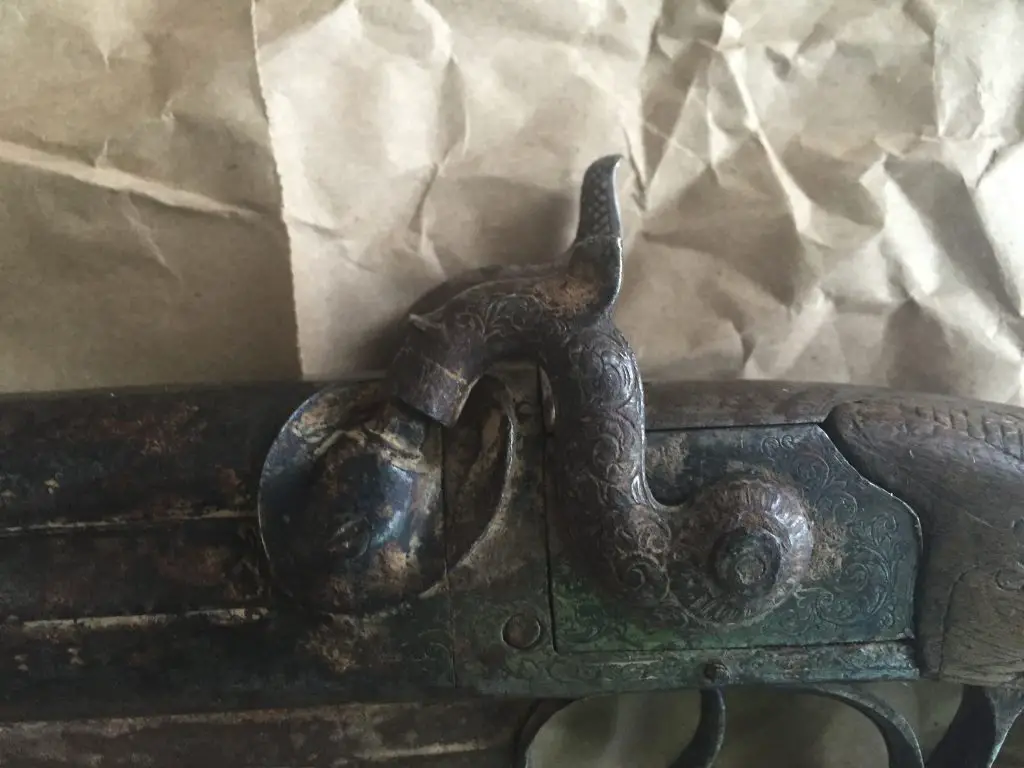
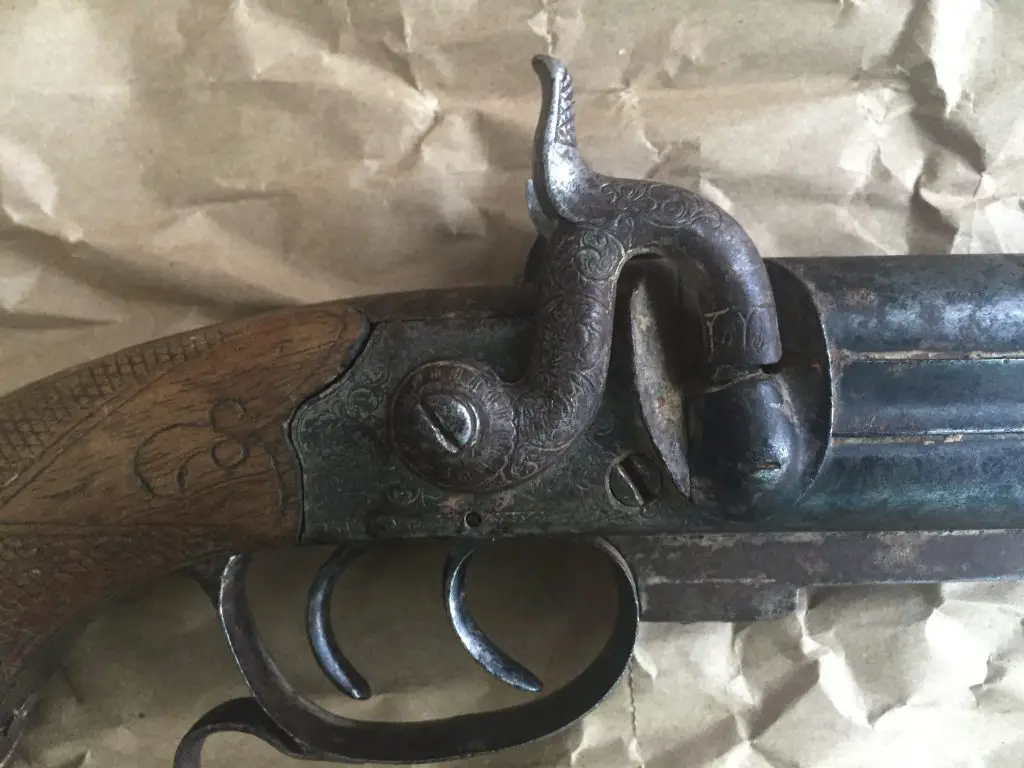 There is one trigger for each lock. At least, that was the smith’s intention — neither one works properly now.
There is one trigger for each lock. At least, that was the smith’s intention — neither one works properly now.
Some metal nubs near the muzzle and a partial ramrod slot underneath the pistol suggest that, at one time, this firearm featured an articulated ramrod.
Here’s the other side:
Caliber is measured at about .52-.54″ (roughly 13 mm) by caliper. There are traces of quite fast right-hand-twist rifling visible in the lower barrel, in the right light.
The grip is noticeably cruder than the rest of the gun, so it may be a replacement. But as mentioned above, the metal parts do not have the fit associated with European and American gunsmiths of this era.
It’s always interesting to speculate about the provenance and history of firearms. Our Afghan seller claimed that this pistol was “very old” and had hung on pegs on the wall of their family’s cob house “since the time of Abdurrahman Shah,” but then, Afghans do say stuff and everybody’s family, everywhere, has legends and tall tales in it.
But along with the tale told here, this pistol played a part in one story that can’t be told — not yet, and possibly not ever. So perhaps it’s a good thing that guns are mere objects, and can’t talk.
Assault Rifle, Alpine Style, Clear as Ice Edition
Thanks to Chuck at GunLab for turning us on to this incredible post on the Swiss Rifles message board. As Chuck tells it, Dale got hold of, not a rare StG 57, but a rare2 cutaway version of the StG 57.
And then he posted a series of photos and a thoughtful analysis of this highly unusual rifle that replaced the Swiss Army’s rifles, light machine guns, and submachine guns at once. (Does that make it the Swiss Army Knife of rifles? Sorry, couldn’t resist.)
As Dale explains, there’s a lot that’s unique about the StG 57:
The Stgw 57 is an interesting battle rifle. The rationale behind this gun was to arm the infantry with an “universal weapon” that would replace the bolt-action rifle, machine gun and machine pistol. It was selected in late December 1956 over the Waffenfabrik Bern competitor for cost reasons (the SIG prototype costed only 495 CHF to produce over the 1100 CHF that the W+F Bern model required).
It was always expensive, and while a semi model sold in trickles in the USA, the high price and the rare (here) 7.5 mm caliber kept it from taking off. One of our team sergeants had one and it was a thing of rare beauty (we think he later traded it for an NFA registered 4.2″ mortar). A later export model was chambered for 7.62 mm NATO, but it didn’t sell any better.
It incorporates a modified roller-delayed blowback mechanism inspired by the StG45/Gerät 06 H prototypes, folding sights from the FG42, and a buttstock socket just like the famous MG42. In order to reduce production costs, SIG used innovative production techniques and rubber/polymer materials for the rifle’s construction, in an effort to minimise the number of machined parts.
The cutaway provides a rare chance to truly observe and understand this unusual weapon. The original post includes comprehensive photographs and explanations.
Of course, being a Swiss rifle, no compromises were made on the quality of the construction and overall robustness. Because of its heavy, welded, machined, stamped and brazed construction, the Stgw 57 weighs a whopping 6,5 kg fully loaded! Not only is the rifle one of the heaviest service weapon of the world, it is also one of the most expensive! Each Stgw 57 costs the Swiss government a grand total of 1000 CHF (of which 495 CHF are production costs and 75 CHF accessories).
In this post, we’ve placed a couple of selected images. But really, you must go there and Read The Whole Thing™; you’ll see many more images and each one has a deep technical description of what you’re seeing. Very highly recommended!
Firepower, Pride, and Prejudice
First, relax: there will be no 19th-Century chick novels, nor any zombies, in this post. The title lead with “Firepower,” right? It’s about guns.
Guns, national pride, and racial or ethnocentric prejudice.
It’s another thing that turns up reading old, old firearms books and magazines, and if you’re old enough you can remember hearing it from gun-store counter clerks and hangers-on (then, as now, literally the worst source of firearms information this side of Hollywood, as they are just as likely to make up random stuff, and less likely to be called on it than movie directors). Hearing what? Things like:
- “Those Jap guns are all junk and are not safe to shoot.”
- “The Italians only expected their rifle to shoot within a couple of feet at a hundred yards.”
- “The Japs in the Pacific -” (wait, were there Japs any other place outside of the 442nd, on our side?) “- lost because they didn’t have any good machine guns.”
- “They forged these guns in hibachis, with child labor.”
These things are all coming to be recognized as arrant nonsense, at least in part by the emergence of specialized collectors who understand them, and publishers who release books about them. But as late as the seventies and eighties, that was the “conventional wisdom” of the countertop commandos.
Exercise for the reader: find a surviving infantry soldier or Marine from Okinawa or Iwo Jima (do it quick, as they’re fewer by the hour; that’s the human condition). Tell him that the Jap machine guns were contemptible. We will counsel you this: do not make that statement from within the radius that he can swing his walker at you. (Here’s video of a Type 99 firing its original 7.7 ammo, and a creative 7.62 x 29 hack. Note the rate of fire: the Marines sure did).
These beliefs got started for several reasons. One is that Japanese and Italian rifles were different to the familiar Springfield and the Mauser from whence its design came. These differences seemed like indicators that the Japanese and Italians didn’t know what they were doing, but if you think about it for a moment, that’s pretty illogical. What nation would consciously issue an inferior or unsafe weapon to its troops? What nation entrusts its weapons design to Bubba the Gunsmite, domestic variation? Not Japan nor Italy (both of which had robust ordnance establishments, as can be seen by their wartime ships’ and aircraft armament, and their talented engineers, as has been proven in peacetime industries postwar), but even today, Japanese and Italian firearms are considered less collectible and less valuable than their global competitors.
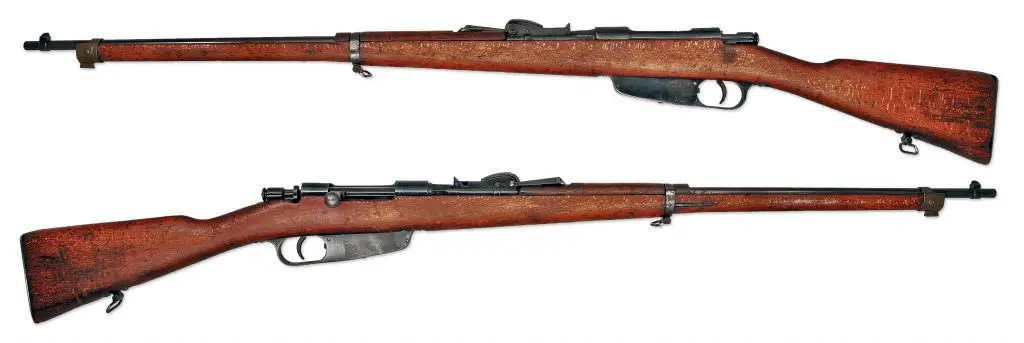
Original M1891 Rifle (with gain twist!) served well in WWI, and derivatives in WWII. Image from C&Rsenal’s great Carcano 91 page. It was sufficiently accurate that the Italians just issued designated marksmen select iron-sighted Carcanos — any scoped “sniper” is a postwar fake, as is any full-length rifle with a turned-down bolt.
One reason for the persistence of dislike of Japanese weapons is their relatively crude finish compared to the beautiful rust-blue of their European counterparts. But this resulted from the fact that Japan at war’s outbreak was as resource-limited as Germany was during the production of “last ditch” weapons, as Shermans and T-34s did celebratory pivot turns on former arms plants. The resource limitation drove the Japanese to innovate, for example going to chrome linings (for strength, not just corrosion resistance) and phosphate finishes (for speed of production, not just corrosion resistance) before most of the world.
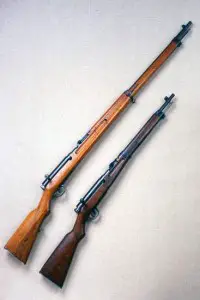
Type 38 (1905) rifle and carbine, 6.5mm. Standard Japanese weapons through early WWII. Not sure where we cribbed this image from — if you know let us know so we can give credit.
Both the “weak” Arisaka and Carcano actions were modern, the Arisaka being a clear Mauser derivative and the Carcano, while a design all its own, offered such modern features as forward dual locking lugs. When introduced (1891), it was arguably the most modern rifle in the world, and like its contemporary the Mosin-Nagant it, and its 6.5 mm cartridge, was still in service at war’s end. (Which came a little earlier for Italy than for the USSR).
Italian and Japanese machine gun designs were different, but that’s not saying that they were practically or tactically inferior. The high rate of fire of the Japanese LMGs is cited in almost every American memoir of Pacific combat. The Japanese could sustain this high rate, especially with the top-mounted magazine of the Type 99. (Guns of this design are much faster to reload, by an a/gunner, than a bottom-loading gun like the BAR is by its single-man crew).
Another reason to disparage these weapons? These nations lost. (Probably not a major reason, given the fanboys of all-things-German loose in the world today. We’re reliably informed that the Third Reich fell short of the planned 1,000 years). In the case of the Italians, there’s also an impression that they lost in part because they weren’t trying terribly hard (probably true for some individuals and not for others). Collectors might want the weapons of losers, just not quitters.
Yet another, and possibly the major, underlying reason for the belief, of course, is the residue of war-era (and “Yellow Peril”-era) racism against the Japanese, and northern European ethnocentrism against Southern Europeans in general, and Italians in particular, from the later waves of United States immigration. These expressions are less open now, but in 1976 you had no difficulty hearing negative impressions of Japanese and Italian firearms by countertop commandos, impressions that were invariably followed up by negative stereotypes (Japanese all had bad vision and made lousy shots; Italians wanted to make love, not war).
Let’s assume arguendo that there are two human phenotypes, call one “martial ardor” or “readiness to fight,” and one “strategic/conceptual ability” or “combat-oriented leadership,” that represent the scrappiness and cunning of a combatant. Let’s further assume that these phenotypes are to some degree heritable, and that there are distinct median levels in these traits in distinct groups. Let us make a fourth assumption, that the medians of these traits might be lower among the Japanese and Italian populations than among, say, Germans.
As the history of the war tells us, these two nations produced men and units that were the equal in “scrappiness” and “cunning” of any force in the world. Consider the thorough Japanese defeat of the ABDA allies in the first six months of the Pacific War, or the Italian naval special operations of the Decimo MAS, or for that matter their forerunners in the war with Austria-Hungary, the first proto-frogmen to sink a battleship.
If you still think that these two great nations produced junk guns, try to get some trigger time on any of the Japanese LMGs, especially the Type 99; or on a Beretta M38 SMG or its derivatives (which is what the MP40 wants to be when it grows up).
And don’t let yourself believe that an enemy weapon is an inferior weapon because you think the enemy is — well, choose your favorite put-down. Because whatever your enemy is, the guys who designed his weapons probably are not.
How Many Rifles, and Where Are They?
Nick Jenzen-Jones has a new and interesting working paper at the Small Arms Survey in Geneva (Here’s the Abstract and the PDF). The title of the paper is dry but promising: Global Development and Production of Self-loading Service Rifles 1896 to the Present.
As always with the Small Arms Survey, this is a publication more aimed at non-proliferation NGOs and quangos than at enthusiasts, but that does not make Nick’s painstaking work any less interesting or useful to us.
Painstaking? It is. He goes deep into the history of semi-automatic and select-fire rifle production over a century and a quarter, and makes a valiant effort to make sense of conflicting numbers that come more from estimates, propaganda, wild guesses, and serial-number sleuthing than they do from any real solid reporting.
Here is a discussion of AK production, probably the toughest nut to crack for those who want to know, “How many?”
AK-type rifles are the most common self-loading service rifle in the world today by a considerable margin, and are thought to constitute in excess of 40 per cent of the total number of self-loading rifles produced up to the present day. Their ubiquity means that they are encountered in almost every modern conflict zone. Nearly 200 variants, copies, and derivatives of the AK rifle have been identified to date.
According to Russian sources, IZHMASH (now Kalashnikov Concern) only patented the weapon’s design in 1997, and in 2006 Russian Federation AK-type rifles accounted for only 10 per cent of the world’s production of this type
The Soviet-era practice was to share their design and engineering widely to encourage production in nearby “fraternal socialist” allies, and to promote industrial development in distant allies. Nations as diverse as India, Iraq, North Korea and Egypt would never have produced AK clones without direct Soviet assistance (the Egyptian plant was even supervised by Soviet engineers, initially, and used every single process of its Soviet prototype).
So the modern Russian inability to issue a concrete figure of X AKs produced is an understandable result of previous policies, as well as of Izmash and Amtorg/Rosoboronexport giving up control of the design of the firearm. The AK’s very simplicity led to further proliferation of manufacture, especially after the 1960s change from machined receiver to stamped with machined and stamped parts riveted in place.
But the paper goes far beyond AKs to discuss the entire history of the self-loading rifle.
Here’s a snip of Table 1 from the paper, which should give you an idea just how thorough and historically interesting it is:
Sure, it’s missing some firearms that were produced in the millions, including the M1/2/3 Carbine (~5.5 million in WWII alone, if memory serves), the G/K 43 (perhaps under a million), and the AG 42 and Hakim. But all of those are obsolete firearms washed away by the tide of ARs, and, especially, AK. And some of them, like the M1 Carbines, are mentioned elsewhere in the report. Sure, you can quibble with the numbers. But the original table includes extensive sourcing and notes. He appears to be, from his notes, excluding firearms produced for civilian markets including non-militarized law enforcement, which means he’s not capturing the bulk of AR production.
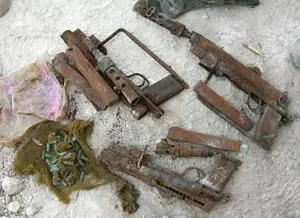
Cached weapons, like these Port Said 9mm SMGs (a license-built Carl Gustav M45B ‘Swedish K’) recovered after decades underground, can last a very long time.
Production, of course, is only half of the conundrum, and Nick tries to understand and estimate inventory shrinkage and diversion, demilitarization and destruction, and wear-out. The problem with that, of course, is not only that there are no comprehensive prior numbers to be exploited as found data, but also that rifles are fiendishly durable goods; and are valuable enough that many possessors will take care to maintain and store them properly, if they can and know how. He makes this note:
International Security Assistance Force (ISAF) troops in Afghanistan captured several well-worn but functional examples of AK and AKM rifles manufactured in the 1950s (Iannamico, 2015).
In fact, in Afghanistan in 2002, our team captured, along with tons of common AKMs and a mountain of World War II weapons, a quantity of prewar Mauser rifles and ZB-26 machine guns, and very first model AK-47s that were 1940s production with a primarily stamped receiver, that pre-date the familiar machined AK-47 receiver. Along with them, we turned up some real oddities like a Ross. All were functional, although there was no ammunition for the .303 and 7.92mm weapons in the caches.
One can quibble with this aspect or that of what Nick has written is, but the fact is that this is the single most comprehensive look at world service rifle stockpiles. Were the numbers to be graphed, they’d need to have really large confidence-interval indications, like error bars or something, because the data are squirrelly, but that’s not his fault. Indeed, to produce a readable, informative document out of such a primordial chaos of data is a signal achievement. We predict that this paper will be widely cited in future scholarship.
One Gun’s Creation Story
These days, and for most of the last century, most of the guns we know and love are the creation of a team, even when they’re generally shaped by the eye and hand of one designer. And the designer usually works for somebody — the concept is often given to the designer by non-design, non-engineer business people or representatives of end users.
Recently, we came across the Creation Story of the relatively common (about 650,000 made) CZ-27 pistol. We have known for a long time that it was a simplified version of the Josef Nickl-designed CZ-22/24 (again, fingering one designer is a simplification: remember, teams). And we knew that the main designer responsible for the changes to the firearm was František Myška (FRON-ti-shek MISH-ka). We believed the gun to be created to be a simpler, blowback pistol in 7.65mm (.32 ACP) for police use.
The story is told various ways by various credible writers. Here’s Max Popenker’s world.guns.ru:
The CZ-27 pistol was developed in around 1926 by Czech arms designer Frantisek Myska in an attempt to produce simplified version of the CZ Vz.24 pistol, chambered for less powerful 7.65×17 SR Browning ammunition (also known as .32 ACP) and suited for police and security use. It was put into production in 1927, at arms factory in Praha.
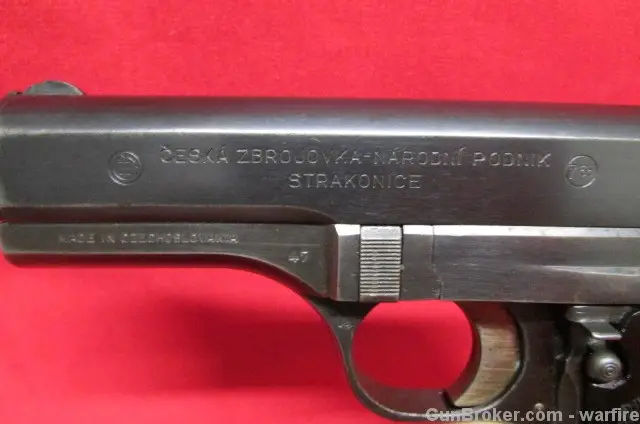 Max is generally correct there. (The pistol was made in Strakonice, not Praga (Prague), but the prewar ones are marked Praha and wartime ones, in German, Prag; that’s where corporate HQ was, even though the production line was in Strakonice, even though that wasn’t ever marked on a CZ-27 until after the war! Like in the example above. That is our one quibble with Max’s description, that, and the understated production figures. OK, two quibbles).
Max is generally correct there. (The pistol was made in Strakonice, not Praga (Prague), but the prewar ones are marked Praha and wartime ones, in German, Prag; that’s where corporate HQ was, even though the production line was in Strakonice, even though that wasn’t ever marked on a CZ-27 until after the war! Like in the example above. That is our one quibble with Max’s description, that, and the understated production figures. OK, two quibbles).
But Czech gunwriter Jiří Fencl, in a new-ish book on Great Czechoslovak Gun Designers, broke it down with much greater precision. Here’s a rough, on-the-fly translation of the story of the creation of the CZ-27 — as told by the designer himself!
František Myška later remembered, “In the course of the manufacture of the pistol vz. 24, one of the then-directors of the company names Beneš came to me (he was known for often happily engaging with the designers) and requested: ‘Mr. Myška, you’re a gunsmith. Could our ‘twenty-four’ be converted to the 7.65 mm cartridge?’”
“I immediately took paper and pencil, and began to draw. In recognition and consideration of the low-powered cartridge, the locking mechanism was not needed, and instead the barrel fixed in place with a pin below. The barrel chambered for 7.65mm. That also led to a smaller grip (smaller magazine). And the Pistol vzor 27 came into the world,” he concluded his tale.
Very well done. And the workshops were able to produce the Pistol CZ model 17 continuously from the year 1927 until the year 1950.
Less well-known are the variants of this pistol adapted for a sound suppressor, and a small-caliber training version for the .22 LR cartridge.
Indeed they are less well-known! We saw a silencer version (without its original silencer) cross the auction block last year, the only one in memory; and we’ve only even seen one .22 version.
Of the major variants, the most common are the German occupation guns, which are marked in the German language (naturally), and the least common the prewar pistol. The postwar pistol is also rare, but not so rare as the 1927-37 original. The postwar pistol seen here bears different markings from prewar guns; instead of CZ being “A.S.” (roughly, “incorporated”), it’s a “Narodní Podník” (“National Enterprise,” the Communist-era organization).
One collector’s website offers photos of some examples of this firearm from throughout its history: there are prewar and postwar Czechoslovak variants, and two different wartime German variants, all of which differ only in small details, finish, and especially markings. The example shown here is from our collection and is a postwar pistol, dated 1947 (by the “47” in front of the takedown catch above); it was replaced in 1950-51 by the vz. 50 pistol, which continued to be numbered in the same series.
For the Man who has Everything: RPG-7 Trainer
Ordnance.com offered this on GunBroker (it will either sell, expire or roll over to a new listing today). It’s a live RPG-7V trainer that shoots, not rocket-propelled grenades, but 7.62 x 39mm rounds. It’s regulated to shoot to the same point that the normal PG-7V grenade hits, with tracer ammo, but it’s all-around a great procedures and marksmanship trainer for this ubiquitous AT weapon. (And anti-personnel weapon. And anti-helicopter weapon. And anti-anything-worth-shooting weapon. And we-Afghans-are-celebrating-a-wedding weapon. And… well, you get the point).
This one’s been modified a little to color within the lines of the National Firearms Act of 1934. First, it can’t load or fire a live PG-7V or other rocket-propelled grenade round, only the subcaliber device. Second, ATF interprets a subcaliber device as a “firearm,” not any specific kind of firearm… but installing it in an RPG-7V, even one that’s been modified so that it cannot fire live rounds, creates a “short barreled rifle.” (Hey, Congress writes the laws and the ATF has to work with them). This is not some experiment that they think will be approved by ATF’s Firearms Technology Branch, but they have the FTB letter.
The shipping/handling case is also a creation of Ordnance.com. It’s an elegant set-up with laser-cut foam for the launcher, subcaliber round, ammo and accessories. The Russians and Soviet satellite forces used to ship these things in wooden crates, like everything else. Russia has plenty of lumber.
This RPG-762 kit contains the following items:
RPG-762 Rocket Launcher Training Kit
- Aluminum hard case, with wheels
- RPG-7 Rocket Launcher
- Optical Sight with soft case
- Bipod assembly
- Sling
- PG-7 7.62x39mm Subcaliber Firearm
- 7.62mm BoreSnake bore cleaner
- 15 rounds of 7.62x39mm Spotter/Tracer Ammunition
- 30 rounds of 7.62x39mm Tracer Ammunition
- Letter from the BATFE which states the launcher is not a destructive device
Overall, the kit is in museum quality condition. The Bulgarian RPG-7 rocket launcher started out as a demiled unit, and we painstakingly reactivated the fire control and have restored the launcher to like-new condition. External finish is not painted, but is a beautiful and very durable glossy powder-coated finish.
The launcher is only capable of firing the PG-7 subcaliber unit, and cannot fire live rockets. The unit was evaluated by the Firearms Technology Branch of the BATF, and it is not classified as a destructive device, but rather a trigger mechanism for the subcaliber firearm. A copy of the BATF’s determination letter will be included with the sale. The subcaliber firearm, which is chambered in 7.62x39mm, is classified as a “firearm only” by the BATF, so the subcal unit must be transferred/shipped to your FFL dealer. You will then go fill out a 4473 form and pick the subcal unit up……just as you would any other regular firearm. There is no special NFA paperwork involved in the purchase or transfer of this kit.
The subcal unit has been modified to work with the launcher, and is also approved by ATF. The subcal unit is not classified as a rifle or a pistol, but just as a “firearm”. The original barrel length was less than 16-inches, so it has been permanently lengthened, so ATF would not classify the subcal unit as a short-barreled rifle, when used in conjunction with the RPG-7 launcher.
The kit is extremely fun to set-up and shoot, and is a fantastic training aid to practice firing the real RPG-7. It is also a stunning display piece, and would be a beautiful display in your office, gun store, firing range, or man cave! The rifling in the subcal unit is over-broached, which makes the grooves extra deep. This was to allow additional blow-by of the propellant gases, and gives the 7.62mm projectile the same trajectory as the real PG-7 rocket propelled grenade that the RPG-7 fires.
You have to admit, that is a solution that is at once ingenious and simple — a Russian solution an American engineer would never think of!
The optics are in beautiful condition, and the optical sight has been sighted in with the subcal unit, and is surprisingly accurate. If you click on the video link below, you can view a YouTube video of us setting up the kit and firing it…..this video will do a better job of explaining how the kit works, than our written description here, so please take a look at the video and the photos. As mentioned previously, the subcal unit will need to be shipped to your FFL dealer. The hard case, along with all of the contents will be shipped directly to you, via UPS Ground insured.
Here’s the video, that they mention above, of this exact system in action :
Just the thing for the advanced Russian small arms collector. The launcher works with the enclosed subcaliber device / dummy round exclusively, and it can be aimed with the optic (ISTR the nomenclature is RPO-7?) or with the back-up iron sights. Yes, every RPG-7 since they were introduced some 55 years ago has BUIS… Ivan had BUIS before BUIS was cool. (The prismatic optic is extremely robust, for what it’s worth).
We’re yuuuuge RPG-7 fans here. It’s a simple weapon, but a reliable, dependable, accurate and powerful one that the US still doesn’t have a real counterpart for, a half century later. We half considered just buying this thing, rather than blogging it and letting one of you guys grab it. But we’ve decided to sleep on it. (And, funny thing: this post was a hasty fill-in because the long, technical post we worked on all day yesterday was not coming together in time. Yet, we like it better than the one we worked on much longer).
Update on the FK Brno 7.5
We have written about this pistol before, but it’s had a long and arduous trip to market, and it’s still not really here. It may finally be coming (and here’s another allegation of imminence from four months ago). In any event, we haven’t got hands on one yet — hell, we haven’t seen one for sale, but we’ve found a couple of articles by people who have handled the gun, not just the press releases. And of course, there’s the manufacturer’s website.
Despite the inventors’ denials, and the gun and ammo’s own unique technology, it clearly owes a great deal to the CZ 75 and its descendants. (That’s not a bad thing, necessarily. After all, everybody owes a great deal to the M1911 and its descendants, too). The lockwork seems similar to the precision-oriented CZ single-actions.
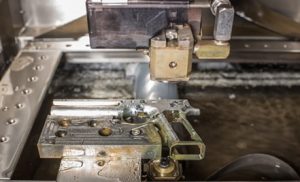 The pistol is manufactured conventionally, for a Czech firearm. That is to say its components are CNC milled from billet or from investment castings (possibly by Poldi, which has cast for ZB and CZ since CZ-Strakonice days, before CZ built the UB factory in 1936).
The pistol is manufactured conventionally, for a Czech firearm. That is to say its components are CNC milled from billet or from investment castings (possibly by Poldi, which has cast for ZB and CZ since CZ-Strakonice days, before CZ built the UB factory in 1936).
But the FK Brno 7.5 offers a unique high-velocity round, a unique buffer system, and unique sights. The FK 7.5 pushes .30 caliber copper bullet at 2000 feet per second, not quite rifle speed, but better than such remarkable rounds as the long-defunct .357 Auto Mag. Its numbers make the .357 SIG look like it has the parking brake on.
It’s otherworldly enough to generate considerable skepticism. When the FK 7.5 first came up on the radar last year, John Zent of American Rifleman noted its sudden appearance on the market had a certain “out-of-nowhere” quality. John Roberts a Guns, Holsters, and Gear also was unimpressed by the claimed velocity, because it can be matched by a 9mm firing an ultralight 50 grain round — delivering half the FK 7.5s energy.
Here is celebrity trainer Rob Pincus, with what he promises is Part I of a multipart article. Rob was invited to the Czech Republic to try the gun during its long period in ATF purgatorio, and has some interesting comments.
A High Capacity Handgun that fires a propriety [sic] 100 grain round at over 2000fps and costs over $5000. The round, by the way, is still moving at 1500fps at 100 meters… which is the distance at which the pistol is zeroed with a unique set of sights when it comes from the factory. As others in the above links note, the gun is relatively large, fires a very powerful round and isn’t going to be cheap. FK BRNO also claims that the gun is very controllable and capable of high levels of precision. And, the only guns currently in the USA are there for government evaluation so that importation could be approved.
Per Pincus, the company considers itself primarily an ammunition research company, which builds the pistol as a way to get its ammo concept into shooters’ hands. He hits these takeaways — and elaborates on each, so you’ll want to Read The Whole Thing™:
- FK BRNO says that they are an Ammunition Company that also makes a handgun.
- FK BRNO set out to develop a handgun that delivered AK-47 performance in regard to Terminal Ballistics at ranges between 50 and 150 meters.
- The 7.5 round delivers high levels [of] precision.
- The Terminal Ballistics are even more impressive than the precision capability.
He concludes: “FK Brno have done what they set out to do.” We’ll say again, Read The Whole Thing™, and we’re looking forward to the next part.
The tactical niche this pistol fills is unclear, although it seems to overdo what the Secret Service and Federal Air Marshals Service selected the .357 SIG to do. It is, without doubt, a magnificent engineering accomplishment, and the prototypes seen so far are beautifully finished. One clue is that, in its native country, it is available in a folding shoulder-stocked version, making it a near-peer of PDWs like the HK MP7 and FN P90 / FiveSeVen combination. It also appeals to people who love that kind of engineering for its own sake.
If it’s a success, it will seem less strange in due course. If it’s not a success, it will be a footnote to firearms history of near-GyroJet proportions. Either way, we want one!
HK433 and the German Competition, Part III
So far, in Part 1 and Part 2, we’ve given you just about everything that Hah und Kah has put out about the new assault rifle family, the HK433. It’s importance for HK is that it’s the company’s entrant in the Bundeswehr competition to replace HK’s own G36. The G36 ran into troubles with shot dispersion in hot conditions, both hot environments and when the gun itself heats up; after a long and unpleasant series of legal maneuvers, German courts ruled that the government was not entitled to recover damages: the G36 met every Bundeswehr requirement, and the hot-conditions test was not anticipated, and so wasn’t a requirement. The rifle’s poor performance in these conditions was a surprise to everybody, including the team that designed it.
And, despite the problem, the German troops that carry the G36 remain generally happy with it; for all the Sturm und Drang in the press (this has been an ongoing Page One story in Germany), troop confidence is not as shaken as you might think. There is no groundswell of German Landsers demanding their G3s back (let alone Opa’s K98k). So the competition has to produce a rifle that’s better than the G36, not only in the view of the theoretically objective testers, but perhaps more importantly in the eyes of the Gefreiter mafia.
While HK’s own HK433 has to be considered the favorite, it’s a big contract (and a German sale increases your odds of selling to fans of German engineering worldwide, including many Third World armies that are larger than the Bundeswehr). So everybody’s going to chase it.
So who else is playing? The German station N TV has a report on the competition, and we’ll translate some passages for you, starting with a shortened version of a paragraph we did in Part I.
Out with the old G36, in with a new standard rifle for the Bundeswehr. …. The firms Sig Sauer s well as Rheimetall in collaboration with Steyr Mannlicher have recently indicated that they want to get the big contract from the Federal Defense Ministry. Now the former top dog and G36 supplier Heckler & Koch chimes in.
After delays the RFP for the major contract should be issued in the first half of 2017, reports the Defense Ministry. Actually a start at the end of 2016 had been envisioned. Due to painstaking preparation of the conract conditions, an “adjustment of the internal timeline” became necessary. The supply of new rifles should begin in 2020 and end 2026; originally 2019 has been named as a possible starting year.
Heckler & Koch and the Defense Ministry? Wasn’t there something about that? Officials and the department head, Ursula von der Leyen, had accused the firm of accuracy problems with the G36 in sustained fire and heat, and demanded damages. But the Koblenz State Court issued von der Leyen a setback in 2016: the judges ruled that, measured by the contract conditions, the rifle had no deficiencies. .
Essentially, the problem they found with the rifle was not a performance measure they specified when they were buying rifles, last time out. The courts ruled that Minister von der Leyen was in the position of someone who bought a car without air conditioning, and then demanded the dealer fix the AC.
But the Minister held to her decision to muster 167,000 G36s out at the end of this decade. In order to find a modern replacement, the Ministry is preparing a request for proposals…. Yet it’s not surprising that the Swabian gunmaker has thrown its hat in the ring. “You have to consider – Heckler & Koch is the official supplier to the Bundeswehr”, Wolf-Christian Paes from the Internationalen Konversionszentrum in Bonn explains. “We want the contract absolutely, for us it is also strategically important,” says Scheuch. His firm is heavily leveraged, but recently has reported better financials.
Does Heckler & Koch start off with a black mark for the big contract, due to the contretemps with the Ministry? “It’s going to be an objective competition,” company head Scheuch says. “The procurement branch of the Bundeswehr is large, versatile, and well organized — any disadvantage from a the person opinion of any individual involved is not a threat.”
Legal experts agree. “That’s not forced optimism from Heckler & Koch”, says contract lawyer Jan Byok from the offices of Bird & Bird. There will be “no whiff of discrimination”. If that were the case, the contract would be legally disputable — something the Government wants to avoid. In a pan-European contest, all participants have equal chances, Byok said.
Weapons expert Paes sees it similarly: from the Bundeswehr he has heard that H&K has considerable understanding there: the firm has provided what was ordered. Had they wanted rifles , that even in continuous fire remained highly accurate, they’d have had to pay more — but that didn’t happen, Paes says.
And then the writer takes a shot at handicapping the field:
Weapons experts see H&K somewhat advantaged, relative to foreign firms: should the US manufacturer Colt join in the competition, the “Bund” would probably prefer the German firm, somewhat, said Paes. “It’s an announced objective of the Government’s industrial policy, to retain manufacturing competence in the country.”
In 2016 H&K got a big contract from the French Army — and defeated the Belgian gunmaker FN. Such successes have consequences for the Bundeswehr contract, lawyer Byok said. … H&K also supplies the armies of Spain, Great Britain, and US special operations forces.
SIG-Sauer also wants the contract. But the Schleswig-Holstein subsidiary of a US business has only 120 employees, H&K on the other hand has 850. Is SIG-Sauer too small? A business has to have a certain minimum size to meet contract terms, says attorney Byok.
They could handle the contract in any case, a SIG-Sauer spokesman reports. “For one, because we have just now already expanded production capacity, for another, because the development of such a contract would take place over a longer period of time. How the race ends is unclear. One thing is certain, for lawyer Byok: the contract will draw the attention of the entire small arms industry. Along with Colt and FN, the Italian gunsmith Beretta and the Czech firm CZ should throw their hats in the ring: “That would be everybody, who has a name and a rank” [in the industry].
That actually winds up being just about the whole article. Let us know if you spot any translation errors.
Exit thought: since nobody has seen the contract yet, what’s the over-under on it having some provision for limited dispersion of rounds from an overheated gun?
Ukraine to Buy 7.62 x 39 mm M16s… from Blimp Impresario?
 We remember where we met Igor Pasternak — at the EAA Airventure in Oshkosh, Wisconsin, the world’s largest airshow — but we don’t remember when. It might have been in the 1990s, or in one of those Augusts of the early oughts we didn’t spend in places named Stan.
We remember where we met Igor Pasternak — at the EAA Airventure in Oshkosh, Wisconsin, the world’s largest airshow — but we don’t remember when. It might have been in the 1990s, or in one of those Augusts of the early oughts we didn’t spend in places named Stan.
Pasternak is a fast moving guy, bursting with energy, with a shock of hair that seemed to be stood up by the electricity within, as if he is his own Van Der Graaf generator. And he burned, inside, with the fire of the True Believer. There are several sub-strains of aviation that attract, well, wild-eyed zealots: one of them is lighter-than-air aircraft. Pasternak was a lighter-than-air True Believer: airships, dirigibles, blimps; the Age of the Zeppelin was ripe for return. And, indeed, he’s had some success with his company Aeros, making both airships (lighter-than-air-craft that can fly under control) and aerostats (tethered balloons) for military uses, even though his real passion is for really large airships for cargo transport.
So it’s kind of amazing to see him and Aeros showing up as the Ukraine’s next vendor of military rifles. But a quick check shows that Worldwide Aeros Corp. has a manufacturer FFL at the same Montebello, California address as Aeros, the blimp guys.
But Aeros will not be building any rifles in its California digs — instead, they will set up the Ukrainians to build their own. From the Ukrainian press:
Sergei Mykytyuk, the director of Ukroboronprom subsidiary Ukroboronservis, told journalists at a January 3 press conference in Kyiv with Aeroscraft CEO Igor Pasternak and Ukroboronprom director Vladimir Korobov, “The first weapon for the pilot project will be manufactured in Ukraine – a model M16 automatic rifle designated the WAC-47. Weapons manufacture to NATO [North Atlantic Treaty Organization] standards is an important part of the development and reform of the Ukrainian military-industrial complex.” Aeroscraft’s Mr. Pasternak added, “The M-16 project was conceived some time ago, as the Ukrainian armed forces, border guards and National Guard will, with time, switch to NATO standards.”
Ukraine’s decision to manufacture assault rifles compatible with NATO standards represents the most decisive break yet with the remnants of its Soviet military-industrial complex heritage. Moreover, it is a significant symbol of Kyiv’s ongoing interest in eventual membership in the North Atlantic alliance.
As for Ukraine’s interaction with the North Atlantic Alliance, Ukroboronprom noted, “Ukrainian soldiers are already participating in joint maneuvers with NATO, there are joint teams with Lithuania and Poland, and the creation of a similar unit with other NATO countries Romania and Bulgaria has been proposed. Furthermore, Ukraine consistently participates in joint peacekeeping operations. And in each case, one of the problems is logistics. For example, in the Polish-Lithuanian-Ukrainian brigade [LitPolUkrBrig], Polish soldiers use the Beryl assault rifle, caliber 5.56×45, while Ukrainian soldiers use the automatic AKM or AKMS, caliber 7.62×39.” The introduction of the WAC-47 in significant numbers to the Ukrainian armed forces would eliminate this logistical bottleneck (Ukroboronprom.com.ua, January 10).
More details of the supposed contract appear in the Western press, but many of these details are not credible. Indeed, there is a lot of nonsense being written about this contract.
In order to modify a Ukrainian M16 to use NATO ammunition, the bolt and barrel will have to be replaced, Brian Summers, a U.S. Army veteran and weapons expert, told The Daily Signal.
“The only items that would have to be replaced are what I would describe as items that would normally be replaced based on use,” Summers said. “The magazines are ammo specific, and would have to be changed to the specific caliber.”
The M16 rifle has two main components—an upper and lower receiver. According to Summers, for a Soviet-caliber M16 to use NATO ammunition, only the upper receiver needs to be modified by replacing the bolt and barrel.
The M16 weapons system is “one of the most versatile weapon platforms in configuration and caliber,” Summers said. “Your troops essentially can train on one platform and when switching over to a new caliber do not need to be retrained in a new weapons system … Core of the platform, lower receiver, does not change and any optics can be moved.”
In the 1990s, Colt Defense LLC, the original M16 producer, produced a special civilian version of the military assault rifle designed to use Soviet 7.62×39 mm ammunition.
“I own this variant and if I want to fire 5.56 mm [NATO ammunition], I simply switch the upper receiver with 5.56 mm bolt and mags,” Summers said. “Two minutes to change.”
Exercise for the reader. Take an AR, any 5.56mm AR. (Most of you have one). Take an AK magazine, any 7.62mm AK mag. (Most of you have one of those, too). Insert Mag A in Magwell B. Wait, what? (The Colt version, long discontinued, uses proprietary magazines, seen with a 7.62 upper and a crude mag made from a 5.56 mag and an AK mag. It was discontinued in part because it doesn’t work terribly well).
A regular AK mag doesn’t go. If you’re a weapons expert, or even an ordinary retired 18B, or even just any one of the ten million Americans that buys an AR every year, you know that. If you’re the kind of “weapons expert” that Newsweek finds, like this guy, you don’t know that. If you’re a reporter, you live your life in the death-grip of the Dunning-Kruger effect about everything, and you can’t tell a phony weapons expert who’s never seen an AR and AK in the same place at the same time from the real thing. But you work for Newsweek, where everything is “too good to check.”
In our opinion, the success of this program is uncertain. The Ukraine does have the aerospace industry necessary for AR parts manufacture, but the guy who’s going to teach them how to do it appears to have no significant background in firearms production. Now, of course, Gaston Glock has no significant background in firearms production before the Glock 17, and neither did many of the aeronautical-engineering experienced engineers at Armalite before the various 1950s Hollywood projects that would culminate in the AR-10 and AR-15. Perhaps some day we’ll all be lining up to buy awesome caliber-convertible carbines from Kiev.
But that’s not the bet that the oddsmakers would put the house money on.
HK433 and the German Competition, Part II
First, apologies to everyone who was expecting this post, as promised, 24 hours ago. We now return you to the weapons discussion formerly in progress! -Ed.
In our report Saturday on the new HK433 military rifle we only included a partial translation of HK’s press release. We stopped because our post was quite long enough, but in the comments many of you asked questions about the items that were not included.
So let’s translate some more HK!
To begin with, we’ve got some marketbrag that we left off last time:
Countless ideas, decades of know-how and mature solutions, tested in the toughest worldwide practice, form the foundation of the trailblazing weapons technologies of Heckler & Koch. In that, the German proportion of value added has remained 100%,since the founding of the traditional enterprise in the Swabian city of Oberndorf in 1949. High-Tech Made in Germany!
Joining with the rifle families G36, HK416 and HK417, combat-proven worldwide, the HK433 is now a fourth scalable assault rifle family in the product portfolio of the enterprise. With this entirely novel development, Heckler & Koch underlines anew its claim to built the best assault rifles in the world. With France (HK416AIF), Germany (G36), USA (US Marine Corps M27/HK416), Great Britain (SA80), Norway (HK416), Spain (G36) und Lithuania (G36) Heckler & Koch already provides the standard assault rifle to a comprehensive number of armies and service branches of NATO. Numerous Special Operations Forces of the western world — including for example the US Special Forces, the Kommando Spezialkräfte of the Bundeswehr (KSK) and civil authorities’ special elements (incl. GSG9) – rely on assault rifles from Oberndorf.
After that, our translation Friday picks up the ball. Until this point:
The Slim Line Handguard developed by Heckler & Koch is firmly attached to the upper receiver, with no play. It can be removed without tools and offers sling attachment points, modular HKey interfaces at 3 and 9 o’clock, as well as a full-length Picatinny rail to MIL-STD-1913 at 6 o’clock.
The interchangeable lower receiver defines the desired operating system and thereby reduces the training demands on the operator. Depending on prior firearms training, the operator can select the G36 or the HK416/AR-15 operating system. All control elements are bilaterally available, symmetrically ordered and can be configured as the customer desires.
“Drop-in” solutions for the lower receiver expand the functional envelope of the weapon with individually configurable match triggers or trigger-group assemblies. The magazine well in compliance with NATO STANAG 4179 (Draft) provides for secure interoperability with the G36 weapons system, the HK416 or the market-standard AR-15.
The grip interface is based on the HK416 weapons family. Through grips with interchangeable grip surfaces and grip backstraps analogous to those of the P30 and SFP/VP pistol series, the rifle can be optimally fitted to various hand sizes.
The ergonomically folding and length-adjustable shoulder stock with the height-adjustable cheekpiece mates with the receiver without any play. The length adjustment offers five detents and is dynamically adjustable for this and the personal combat equipment of the operator. Straight, convex and concave buttplates ensure the necessary comfort with the weapon at the ready position. The shoulder stock can be folded to the right at any length adjustment. Here the most extremely compact transport measurements are achieved. The trigger remains freely accessible. The ejection port is not covered, to ensure that in an emergency a functional capability is available even in “transport condition.”
H&K weapons are distinguished, along with the highest reliability, also by a standard-setting safety standard. So on the HK433 firing readiness, drop safety (NATO AC225/D14), the ability to safe the weapon in all loading conditions and a high cook-off safety are understood, along with a robust and non-delicate manner of construction, even in dirty, extreme cold and war temperature conditions, or lacking lubricants.
Camouflage colors and infrared-absorbing finishes are available, if desired by customers.
Special material combinations and surface treatments round out the whole concept of the HK433. They provide for a low-maintenance system under extreme conditions, with an above-average service life.
The empty weight of the HK433 with the 16.5″ long barrel is 3.5 kg.
Here’s the original .pdf in The Awful German Language:
20170203_Pressemitteilung_-HK433.pdf
Now you’re caught up on what HK has said. Tomorrow, assuming of course that the system continues working, we’ll have an update on who’s expected to be playing in the German rifle competition. HK, as the largest German firm participating and the only one offering a 100% German-designed, German-produced weapon from a factory ready to deliver immediately, is thought to have the inside track.

Kevin was a former Special Forces weapons man (MOS 18B, before the 18 series, 11B with Skill Qualification Indicator of S). His focus was on weapons: their history, effects and employment. He started WeaponsMan.com in 2011 and operated it until he passed away in 2017. His work is being preserved here at the request of his family.

